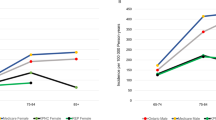Abstract
Parkinson’s disease is known to pose a relevant burden to society in industrialized countries. However, not much research has been conducted on the epidemiology of this disease in Italy. Our aim was to estimate the incidence rate and prevalence of Parkinson’s disease in the Italian Friuli Venezia Giulia region using administrative health-related databases. Five regional administrative databases (hospitalizations, exemptions from medical charges, drug prescriptions, nursing homes, and home visits) were individually linked with one another through an anonymous stochastic univocal key. Using a pre-defined algorithm, incident and prevalent cases of Parkinson’s disease were identified for the year 2016. The estimated regional incidence rate was 0.28 new cases/1000 person-years; prevalence was 3.89/1000 inhabitants. Both increased with increasing age and were higher among males than among females. A considerable proportion of prevalent cases was admitted to the hospital or nursing home in 2016, whereas only a few received home visits by health professionals. The incidence and prevalence of the disease were considerable, especially in the older population, indicating the need to develop multidisciplinary models to care for patients living in the region.

Similar content being viewed by others
References
Lee A, Gilbert RM (2016) Epidemiology of Parkinson disease. Neurol Clin 34(4):955–965. https://doi.org/10.1016/j.ncl.2016.06.012
Baldereschi M, Di Carlo A, Rocca WA, Vanni P, Maggi S, Perissinotto E, Grigoletto F, Amaducci L, Inzitari D (2000) Parkinson’s disease and parkinsonism in a longitudinal study: two-fold higher incidence in men. ILSA Working Group. Italian longitudinal study on aging. Neurology 55(9):1358–1363. https://doi.org/10.1212/WNL.55.9.1358
Chillag-Talmor O, Giladi N, Linn S, Gurevich T, El-Ad B, Silverman B, Friedman N, Peretz C (2011) Use of a refined drug tracer algorithm to estimate prevalence and incidence of Parkinson’s disease in a large Israeli population. J Parkinsons Dis 1(1):35–47. https://doi.org/10.3233/JPD-2011-11024
Huber CA, Szucs TD, Rapold R, Reich O (2013) Identifying patients with chronic conditions using pharmacy data in Switzerland: an updated mapping approach to the classification of medications. BMC Public Health 13(1):1030. https://doi.org/10.1186/1471-2458-13-1030
Chini F, Pezzotti P, Orzella L, Borgia P, Guasticchi G (2011) Can we use the pharmacy data to estimate the prevalence of chronic conditions? A comparison of multiple data sources. BMC Public Health 11(1):688. https://doi.org/10.1186/1471-2458-11-688
Moisan F, Kab S, Mohamed F, Canonico M, Le Guern M, Quintin C, Carcaillon L, Nicolau J, Duport N, Singh-Manoux A, Boussac-Zarebska M, Elbaz A (2016) Parkinson disease male-to-female ratios increase with age: French nationwide study and meta-analysis. J Neurol Neurosurg Psychiatry 87(9):952–957. https://doi.org/10.1136/jnnp-2015-312283
Baldacci F, Policardo L, Rossi S, Ulivelli M, Ramat S, Grassi E, Palumbo P, Giovannelli F, Cincotta M, Ceravolo R, Sorbi S, Francesconi P, Bonuccelli U (2015) Reliability of administrative data for the identification of Parkinson’s disease cohorts. Neurol Sci 36(5):783–786. https://doi.org/10.1007/s10072-015-2062-z
Tominz R, Marin L, Mezzarobba S (2015) Estimate of the prevalence of Parkinson’s disease by using electronic health archives. Recenti Prog Med 106(2):97–102. https://doi.org/10.1701/1790.19496
Ministero della Salute (2017) Elenco malattie e condizioni croniche e invalidanti, http://www.trovanorme.salute.gov.it/norme/renderPdfspring?seriegu=SGdatagu=18/03/2017redaz=17A02015artp=13art=1subart=1subart1=10vers=1prog=001 Accessed 21 Nov. 2017
Ministero della Salute (2017) Elenco malattie rare esentate dalla partecipazione al costo, http://www.trovanorme.salute.gov.it/norme/renderPdfspring?seriegu=SGdatagu=18/03/2017redaz=17A02015artp=12art=1subart=1subart1=10vers=1prog=001 Accessed 21 Nov. 2017
Guo S, Huang J, Jiang H, Han C, Li J, Xu X, Zhang G, Lin Z, Xiong N, Wang T (2017) Restless legs syndrome: from pathophysiology to clinical diagnosis and management. Front Aging Neurosci 9(171). https://doi.org/10.3389/fnagi.2017.00171
Paviour DC, Surtees RA, Lees AJ (2004) Diagnostic considerations in juvenile parkinsonism. Mov Disord 19(2):123–135. https://doi.org/10.1002/mds.10644
Deloitte Access Economics (2015). Living with Parkinson’s disease. An updated economic analysis 2014. Parkinson’s Australia Inc.
Boersma I, Jones J, Coughlan C, Carter J, Bekelman D, Miyasaki J, Kutner J, Kluger B (2017) Palliative care and Parkinson’s disease: caregiver perspectives. J Palliat Med 20(9):930–938. https://doi.org/10.1089/jpm.2016.0325
Kluger BM, Fox S, Timmons S, Katz M, Galifianakis NB, Subramanian I, Carter JH, Johnson MJ, Richfield EW, Bekelman D, Kutner JS, Miyasaki J (2017) Palliative care and Parkinson’s disease: meeting summary and recommendations for clinical research. Parkinsonism Relat Disord 37:19–26. https://doi.org/10.1016/j.parkreldis.2017.01.008
Fereshtehnejad SM (2016) Strategies to maintain quality of life among people with Parkinson’s disease: what works? Neurodegener Dis Manag 6(5):399–415. https://doi.org/10.2217/nmt-2016-0020
Qamar MA, Harington G, Trump S, Johnson J, Roberts F, Frost E (2017) Multidisciplinary Care in Parkinson’s disease. Int Rev Neurobiol 132:511–523. https://doi.org/10.1016/bs.irn.2017.02.001
Istat (2014) Annuario statistico italiano. Istat, Roma
Author information
Authors and Affiliations
Corresponding author
Ethics declarations
This article does not contain any studies with human or animal subjects performed by any of the authors.
Since this analysis was based on anonymous administrative data, patients’ informed consent and Ethical Committee approval were not required in Italy.
Conflicts of interest
The authors declare that they have no conflict of interest.
Rights and permissions
About this article
Cite this article
Valent, F., Devigili, G., Rinaldo, S. et al. The epidemiology of Parkinson’s disease in the Italian region Friuli Venezia Giulia: a population-based study with administrative data. Neurol Sci 39, 699–704 (2018). https://doi.org/10.1007/s10072-018-3273-x
Received:
Accepted:
Published:
Issue Date:
DOI: https://doi.org/10.1007/s10072-018-3273-x




